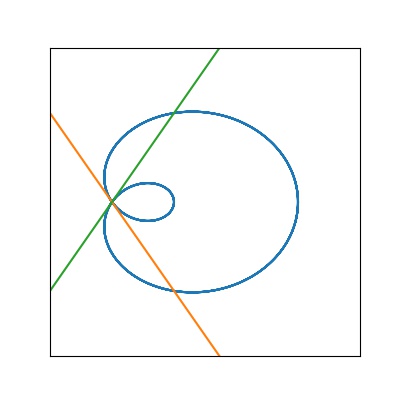Introduction to Curves
Defining a curve
Level Curves
A 2D curve can be described by means of their Cartesian equation \(f(x, y) = c\) and the curve is a set of points
A 3D curve can be described by 2 equations \(f_1(x, y, z) = c_1, f_2(x,y,z) = c_2\) s.t.
A level curve is a set of points which the quantity \(f(x, y)\) reaches the 'level' \(c\).
Parameterized Curve
A parameterized curve is a map
A parameterization of level curve \(C\) is a parametrized curve, whose image is contained in \(C\).
The parameterization of a curve is not unique, for example, the image of \((\cos t, \sin t)\) is equal to \((\cos 2t, \sin 2t)\)
Example If \(\gamma(t) = (t^2, t^4)\) is parameterization of \(y = x^2\)?
No, note that \(1 = (-1)^2\), while for any \(t \in \mathbb R\), \(t^2 \geq 0\) so that we cannot parameterize \(y=x^2\).
Example Find the parameterization of \(\frac{x^2}{4} + \frac{y^2}{9} = 1\).
Take \((2\cos t, 3\sin t)\), note that \(\frac{(2\cos t)^2}{4} + \frac{(3\sin t)^2}{9} = \cos t^2 + \sin t^2 = 1\)
Example Find the Cartesian equations of \(\gamma(t) = (e^t, t^2)\).
Let \(x = e^t\), then \(t = \log x,\implies y = t^2 = (\log x)^2\).
Smooth Curve
A parameterized curve \(\gamma\) is smooth if \(\gamma\) is infinitely differentiable for all \(t \in (a, b)\). Note that since \(\gamma: (a, b)\rightarrow\mathbb R^n\), its derivative is defined as a vector-valued function and each derivative on each component. We will often denote \(\dot\gamma:=\frac{d\gamma}{dt}, \ddot\gamma := \frac{d^2\gamma}{dt^2}\).
Tangent Vector
Let \(\gamma(t)\) be a parameterized curve, then \(\dot\gamma(t)\) is the tangent vector of \(\gamma\) at point \(\gamma(t)\).
Theorem If the tangent vector of a parameterized curve is constant, then the image of the curve is (part of) a straight line.
proof. Assume \(\dot\gamma(t) = \mathbf a\) for all \(t\). Then, integrate \(\dot\gamma\) component-wise,
Example Consider the parameterized curve \(\gamma(t) = ((1 + 2\cos t)\cos t, (1 + 2 \cos t) \sin t)\). Its tangent vector is
Note that \(\gamma\) has a self-intersection at \(\gamma(2\pi / 3) = \gamma(4\pi / 3) = (0, 0)\), while
Source code
import numpy as np
import matplotlib.pyplot as plt
t = np.arange(-4 * np.pi, 4 * np.pi, 0.001)
x = (1 + 2 * np.cos(t)) * np.cos(t); y = (1 + 2 * np.cos(t)) * np.sin(t)
dx1 = 3 ** 0.5 / 2 * t; dy1 = -3 / 2 * t
dx2 = -3 ** 0.5 / 2 * t; dy2 = -3 / 2 * t
plt.figure(figsize=(4, 4)); plt.xlim(-1, 4); plt.ylim(-3, 3)
plt.xticks([]); plt.yticks([])
plt.plot(x, y); plt.plot(dx1, dy1); plt.plot(dx2, dy2)
plt.savefig("../assets/intro_curves.jpg")
Example: Foci of ellipse
Consider the ellipse \(\frac{x^2}{p^2}+ \frac{y^2}{q^2} = 1, p > q > 0\), using the parameterization \(\gamma(t) = (p\cos t, q\sin t)\).
Define the eccentricity of the ellipse as \(\epsilon = \sqrt{1 - \frac{q^2}{p^2}}\) and the foci of the ellipse as \(\mathbf f_1 = (- \epsilon p, 0), \mathbf f_2 = (\epsilon p, 0)\).
Claim \(\forall a \in C. d(\mathbf f_1, a) + d(\mathbf f_2, a)= \mathbf c\) where \(\mathbf c\) does not depend on \(a\).
proof. Let \(a\in C\), take some \(t_0\) s.t. \(a = (p\cos t_0, q\sin t_0)\). Consider \(d(a, \mathbf f_1)\)
Then, taking the square root, notice that \(\epsilon < 1. -1 < \cos t_0 < 1\) so that \(1 - \epsilon\cos t_0\) > 0. \(d(a, \mathbf f_1) = p(1 - \epsilon \cos t_0)\). Similarly, \(d(a, \mathbf f_2) = p(1 + \epsilon \cos t_0)\). Therefore,
Claim \(\forall a \in C\). The product of the distances from \(\mathbf f_1\) and \(\mathbf f_2\) to the tangent line at \(a\) does not depend on \(a\).
proof. For some \(t\), the tangent line is
Hence the normal is \(\mathbf n(t) = (q\cos t, p\sin t)\) so that \(\gamma'(t)\cdot \mathbf n(t) =\mathbf 0\). Note that the distance between some point \(\mathbf f_1\) and the tangent line is \((\mathbf f_1 - a)\cdot \frac{\mathbf n}{\|\mathbf n\|}\). Therefore, the product is
Example (Viviani's Curve)
Show that
is a parameterization of the curve of intersection of the cylinder of radius \(1/2\) and axis the z-axis with the sphere of radius \(1\) and center \((-1/2, 0, 0)\).
The surface of the circle can be represented as
The surface of the cylinder is
Let \(z = \sin t\), we have the equations
solves to have \(x + 1/2 = 1 - \sin^2 t\Rightarrow x = \cos^2 t - 1/2\),
then \(y = \sqrt{1/4 - (\cos^2 t - 1/2)^2} = \sqrt{\cos^2 t(1-\cos^2 t)} = \sin t\cos t\).
